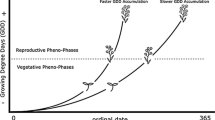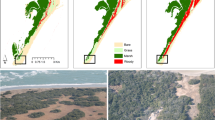Abstract
Microclimate is the most appropriate measure of climate affecting species. Understanding microclimate variation is essential for predicting effects of climate change on species. This study examined (1) variation in microclimate temperatures associated with Azorella selago Hook. (Apiaceae) across Marion Island, (2) differences between microclimate temperature and meteorological station temperatures, and (3) effect of A. selago on microclimate temperatures. Microclimate temperatures were shown to vary significantly with altitude and island side. The microclimate associated with A. selago was also more extreme than meteorological station temperature ranges suggest. A. selago was shown to ameliorate temperature conditions compared to those on the ground. Given the biotic differences that have been documented between the sides of Marion Island, this finding argues strongly for improved understanding of spatial variability in Marion Island’s climate. Such understanding is particularly critical given the rapid rate of climate change currently being experienced by the island.






Similar content being viewed by others
References
Bale CL, Williams JB, Charley JL (1998) The impact of aspect on forest structure and floristics in some Eastern Australian sites. Forest Ecol Manag 110:363–377
Barendse J, Chown SL (2001) Abundance and seasonality of mid-altitude fellfield arthropods from Marion Island. Polar Biol 24:73–82
Batabyal AA (2002) Human actions, the survival of keystone species, and the resilience of ecological-economic systems. Resource Policy 28:153–157
Becker T, Dietz H, Billeter R, Buschmann H, Edwards PJ (2005) Altitudinal distribution of alien plant species in the Swiss Alps. Perspect Plant Ecol Evol Syst 7:173–183
Blake BJ (1996) Microclimate and prediction of photosynthesis at Marion Island. MSc Thesis, University of the Orange Free State, South Africa
Boelhouwers J, Holness S, Summer P (2003) The maritime Subantarctic: a distinct periglacial environment. Geomorphology 52:39–55
Cavieres LA, Badano EI, Sierra-Almeida A, Molina-Montenegro MA (2007) Microclimatic modifications of cushion plants and their consequences for seedling survival of native and non-native herbaceous species in the high Andes of central Chile. Arctic Antarct Alpine Res 39:229–236
Chown SL, Crafford JE (1992) Microhabitat temperatures at Marion Island (46°54′ S 37°45′ E). S Afr J Antarct Res 22:51–58
Convey P (1997) How are the life history strategies of Antarctic terrestrial invertebrates influenced by extreme environmental conditions? J Therm Biol 22:429–440
Convey P (2001) Terrestrial ecosystem responses to climate changes in the Antarctic. In: Walther GR, Burga CA, Edwards PJ (eds) “Fingerprints” of climate change: adapted behaviour and shifting species ranges. Kluwer Academic/Plenum Publishers, New York, pp 17–42
Davies KF, Melbourne BA (1999) Statistical models of invertebrate distribution on Macquarie Island: a tool to assess climate change and local human impacts. Polar Biol 21:240–250
Easterling DR, Horton B, Jones PD, Peterson TC, Karl TR, Parker DE, Salinger MJ, Razuvayev V, Plummer N, Jamason P, Folland CK (1997) Maximum and minimum temperature trends for the globe. Science 277:364–367
Fortin M-J, Dale M (2005) Spatial analysis a guide for ecologists. Cambridge University Press, Cambridge
Frenot Y, Gloaguen J-C, Cannavacciuolo M, Bellido A (1998) Primary succession on glacier forelands in the subantarctic Kerguelen Islands. J Veg Sci 9:75–84
Gabriel AGA, Chown SL, Barendse J, Marshall DJ, Mercer RD, Pugh PJA, Smith VR (2001) Biological invasions of Southern Ocean islands: the Collembola of Marion Island as a test of generalities. Ecography 24:421–430
Gremmen NJM (1981) The vegetation of the sub-Antarctic islands, Marion and Prince Edward. Junk, The Hague
Gremmen NJM (1997) Changes in the vegetation of sub-Antarctic Marion Island resulting from introduced vascular plants. In: Battaglia B, Valencia J, Walton DWH (eds) Antarctic communities: species, structure and survival. Cambridge University Press, Cambridge, pp 417–423
Gremmen NJM, Chown SL, Marshall DJ (1998) Impact of the introduced grass Agrostis stolonifera on vegetation and soil fauna communities at Marion Island, sub-Antarctic. Biol Conserv 85:223–231
Griffiths JF (1976) Climate and the environment: the atmospheric impact on man. Elek Brooks Ltd, London
Harlow RC, Burke EJ, Scott RL, Shuttleworth WJ, Brown CM, Petti JR (2004) Research note: derivation of temperature lapse rates in semi-arid south-eastern Arizona. Hydrol Earth Syst Sci 8:1179–1185
Heegaard E, Vandvik V (2004) Climate change affects the outcome of competitive interactions—an implication of principal response curves. Oecologia 139:459–466
Holness SD (2001) Periglacial slope processes, landforms and environment at Marion Island, maritime Subantarctic. PhD Thesis, University of the Western Cape, South Africa
Hugo EA (2006) Spatial patterns in the microarthropod community associated with Azorella selago (Apiaceae) on the sub-Antarctic Prince Edward Islands. PhD Thesis, University of Stellenbosch, South Africa
Hugo EA, McGeoch MA, Marshall DJ (2004) Fine scale variation in microarthropod communities inhabiting the keystone species Azorella selago on Marion Island. Polar Biol 27:466–473
Hummel I, Quemmerais F, Gouesbet G, Amrani AE, Frenot Y, Hennion F, Couée I (2004) Characterisation of environmental stress responses during early development of Pringlea antiscorbutica in the field at Kerguelen. New Phytol 162:705–715
Huntley BJ (1972) Notes on the ecology of Azorella selago Hook. S Afr J Bot 38:103–113
Jones HG (1992) Plants and microclimate: a quantitative approach to environmental plant physiology, 2nd edn. Cambridge University Press, New York
Körner C (2003) Alpine plant life: Functional plant ecology of high mountain ecosystems. 2nd edn. Springer, New York, pp 344. ISBN 3-540-00347-9
Le Roux PC (2007) Climate and climate change. In: Chown SL, Froneman PW (eds) The Prince Edward Islands: Land–sea interactions in a changing ecosystem. African SunMedia, Stellenbosch (in press)
Le Roux PC, McGeoch MA (2004) The use of size as an estimator of age in the sub-Antarctic cushion plant, Azorella selago (Apiaceae). Arct Antarct Alp Res 36:509–517
Le Roux PC, McGeoch MA, Nyakatya MJ, Chown SL (2005) Effects of a short-term climate change experiment on a sub-Antarctic keystone plant species. Global Change Biol 11:1–12
Le Roux PC, McGeoch MA (2007) Changes in climate extremes, variability and signature on sub-Antarctic Marion Island. Clim Chang. doi:10.1007/s10584-007-9259-y
McCarty JP (2001) Ecological consequences of recent climate change. Conserv Biol 15:320–331
Mc Cullagh P, Nelder JA (1989) Generalized linear models, 2nd edn. Chapman & Hall, London
McGeoch MA (2006) Climate change biology. In: Riffenburgh B (ed) Encyclopedia of the Antarctic. Routledge, New York, pp 255–257
McGeoch MA, le Roux PC, Hugo EA, Chown SL (2006) Species and community responses to short-term climate manipulation: Microarthropods in the sub-Antarctic. Aust Ecol 31:719–731
McGeoch MA, Le Roux PC, Hugo EA, Nyakatya MJ (2007) Spatial variation in the terrestrial biotic system. In: Chown SL, Froneman PW (eds) The Prince Edward Islands: Land-sea interactions in a changing ecosystem. African SunMedia, Stellenbosch (in press)
Parmesan C, Ryrholm N, Stefanescu C, Hill JK, Thomas CD, Descimon H, Huntley B, Kaila L, Kullberg J, Tammaru T, Tennent WJ, Thomas JA, Warren M (1999) Poleward shifts in geographical ranges of butterfly species associated with regional warming. Nature 399:579–583
Pyšek P, Liška J (1991) Colonisation of Sibbaldia tetrandra cushions on alpine scree in the Pamiro-Alai Mountains, Central Asia. Arct Alp Res 23:263–272
Quinn GP, Keough MJ (2002) Experimental design and data analysis for biologists. Cambridge University Press, Cambridge
Robinson SA, Wasley J, Tobin AK (2003) Living on the edge—plants and global change in continental and maritime Antarctica. Global Chang Biol 9:1681–1717
Rosenberg NJ, Blad BL, Verma SB (1983) Microclimate: the biological environment, 2nd edn. Wiley, New York
Root TL, Price JT, Hall KR, Schneider SH, Rosenzweig C, Pounds JA (2003) Fingerprints of global warming on wild animals and plants. Nature 421:57–60
Rouault M, Mélice JL, Reason CJC, Lutjeharms JRE (2005) Climate variability at Marion Island, Southern Ocean, since 1960. J Geogr Res 110:1–9
Schulze BR (1971) The climate of Marion Island. In: van Zinderen Bakker EM, Winterbottom JM, Dyer RA (eds) Marion and Prince Edward Islands: report on the South African biological and geological expeditions, 1965−1966. A.A. Balkema, Cape Town, pp 16–31
Schoettle AW, Rochelle SG (2000) Morphological variation of Pinus flexilis (Pinaceae), a bird-dispersed pine, across a range of elevations. Am J Bot 87:1797–1806
Smith VR (1978) Plant ecology of Marion Island—a review. S Afr J Antarct Res 8:21–30
Smith VR, Steenkamp M (1990) Climatic change and its ecological implications at a subantarctic island. Oecologia 85:14–24
Smith VR, Steenkamp M, Gremmen NJM (2001) Vegetation and edaphic attributes of the terrestrial habitats on Marion Island. S Afr J Bot 67: 641–654
Smith VR (2002) Climate change in the sub-Antarctic: an illustration from Marion Island. Clim Chang 52:345–357
Smith VR, Mucina L (2005) Vegetation of sub-Antarctic Marion and Prince Edward Islands. Strelitzia 16:1–26
Terblanche JS, Sinclair BJ, Klok CJ, McFarlane ML, Chown SL (2005) The effects of acclimation on thermal tolerance, desiccation resistance and metabolic rate in Chirodica chalcoptera (Coleoptera: Chrysomelidae). J Insect Physiol 51:1013–1023
Thomas CD, Lennon J (1999) Birds extend their range northwards. Nature 399:213–234
Thost D, Allison I (2005) The climate of Heard Island. In: Green K, Whoeler EJ (eds) Heard Island: Southern Ocean Sentinel. Surrey Beatty & Sons, Sydney, pp 62–68
Tweedie CE, Bergstrom D (2000) A climate change scenario for surface air temperature at Subantarctic Macquarie Island. In: Davison W, Howard-Williams C, Broady P (eds) Antarctic ecosystems: models for wider ecological understanding. New Zealand Natural Sciences, Christchurch, pp 272–281
Unwin DM (1980) Microclimate measurements for ecologists. Academic, London
Van Zinderen Bakker EM (1978) Origin and general ecology of the Marion Island ecosystem. S Afr J Antarct Res 8:13–20
Walther G, Post E, Convey P, Menzel A, Parmesan C, Beebee TJC, Fromentin JM, Hoegh-Guldberg O, Bairlein F (2002) Ecological response to recent climate change. Nature 416:389–395
Walther G (2003) Plants in a warmer world. Perspect Plant Ecol Evol Syst 6:169–185
Wookey PA, Parsons AN, Welker JM, Potter JA, Callaghan TV, Lee JA, Press MC (1993) Comparative responses of phenology and reproductive development to simulated environmental change in sub-antarctic and high arctic plants. Oikos 67:490–502
Acknowledgments
The Marion Island shape-files were supplied by the Department of Land Affairs (Directorate: Surveys and Mapping), South Africa. We thank K.I. Meiklejohn and J.M. Kalwij for their modifications to the map. The South African Weather Service provided the Marion Island meteorological station data. Thanks are also due to P.C. Le Roux, J. Boelhouwers and N. Gremmen for valuable comments and discussion. This material is based upon work supported by the South African National Antarctic Programme of the National Research Foundation.
Author information
Authors and Affiliations
Corresponding author
Rights and permissions
About this article
Cite this article
Nyakatya, M.J., McGeoch, M.A. Temperature variation across Marion Island associated with a keystone plant species (Azorella selago Hook. (Apiaceae)). Polar Biol 31, 139–151 (2008). https://doi.org/10.1007/s00300-007-0341-8
Received:
Revised:
Accepted:
Published:
Issue Date:
DOI: https://doi.org/10.1007/s00300-007-0341-8




